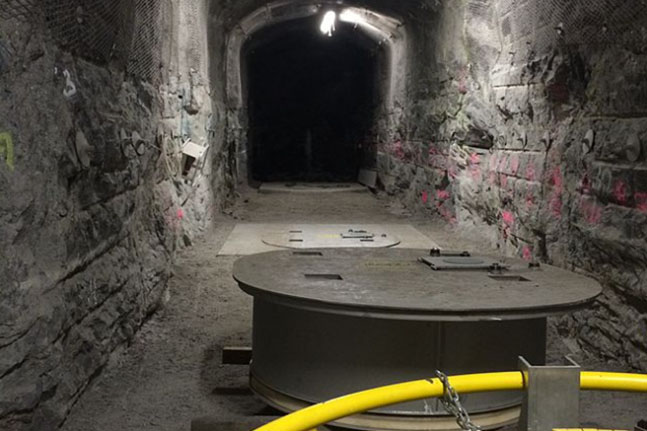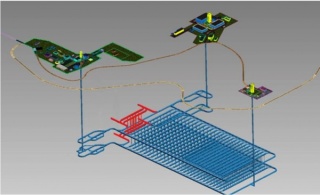
From Ukraine peace plans to Kazakh uranium—all that and more in our new nuclear digest
Our November Nuclear Digest by Bellona’s Environmental Transparency Center is out now. Here’s a quick taste of just three nuclear issues arising in U...
News

Publish date: October 21, 2014
News
NO RAO, the Russian state’s national operator for dealing with radioactive waste, has announced it will build an underground research laboratory near Krasnoyarsk to determine the feasibility of building a final disposal point for the country’s high-level radioactive waste by 2024, NO RAO reported on its website.
The government agency reported it had chosen the Nizhnekansky Rock Mass in the Krasnoyarsk Region of Central Siberia as the site for the lab and eventual long term underground storage repository, as so identified in the Russian government’s November 2013 Regional Energy Planning Scheme.
The project to build the repository will only go ahead pending the results of the lab studies, NO RAO said.
Russian state nuclear corporation Rosatom said that phase one of the proposed repository would hold 20,000 tons of intermediate and high level nuclear wastes, which would be retrievable, World Nuclear News reported.

NO RAO, which is only three years old, made the announcement of the target date for ramping up the laboratory on October 15, following a board meeting of the Krasnoyarsk Citizens’ Assembly, though didn’t post any news on the outcome until two days later.
The site republished an article from the sibnovosti.ru news portal (in Russian) stating that the meeting had been “open” and had included the participation of representatives of various government and municipal agencies, Rosatom, and ecologists and scientific activists from the Krasnoyarsk region.
Locals push for transparency
Krasnoyarsk Citizens’ Assembly Chairman Alexei Menshikov was reported as saying the decision to build the repository in the region’s Nizhnekansky Rock Mass would not be decided without “wide public discussion and the creation of effective means for civil control, because [the repository] concerns environmental safety and the livelihood of citizens.”
Many of those present at the meeting pressed questions on precisely those points.
This area in Siberia is no stranger to massive nuclear undertakings. The nearby closed nuclear city of Zheleznogorsk through the decades of the Cold War produced bomb grade plutonium.
The city is also gearing up to build a new pilot spent nuclear fuel storage and reprocessing facility, which will reprocess two of Russia’s thorniest types of spent nuclear fuel: that produced by VVER-1000 reactors and spent fuel from Chernobyl-style RBMKs.
Zheleznogorsk Mayor Vadim Medvedev told the October 15 hearing that the “technical culture” of Zheleznogorsk and dialogue between the closed city’s nuclear experts and environmentalists would guarantee safety.

Assurances are nice, but ecologists demand guarantees
Environmentalists are not quick to take such assurances at face value, and like Menshikov, say this project can only fly if total transparency is guaranteed.
Russia’s preeminent environmentalist Alexei Yablokov reiterated that point to Bellona in an email.
“The whole decision-making process that could lead to the creation of the Krasnoyarsk repository for radioactive waste must be transparent for the entire public of the Krasnoyarsk Region, and not just residents of the closed city of Zheleznogorsk,” he wrote.
Nils Bøhmer, Bellona’s managing director and nuclear physicist, who next month plans to visit the site of the repository, agreed.
“That the laboratory is being built is a good first step,” he said. “But the site selection process and what the laboratory’s studies reveal must be made absolutely accessible to the public in a completely transparent fashion.”
The brass tacks of the Oct 15 meeting
Nikolai Lobanov, NO RAO’s director for large-scale construction, showed the October 15th gathering engineering documents for the laboratory that would test the possibility of building the underground storage facility. The blueprints included mock-ups of defensive barriers and isolation chambers.
The laboratory itself will be built on the so-called Yesensky plot, and will study the possibilities of sinking storage chambers for high-level radioactive waste in various parts of the Nizhnekansky Rock Mass at depths of 450 to 535 meters.
According to the sibnovosti report, the decision to get the lab up and running still relies on confirmations that the laboratory poses none of the environmental dangers discussed by Menshikov.
If given the nod, the laboratory will run tests and collect geological and environmental data for nine years, specifically on whether the Nizhnekansky Rock Mass meets with international standards, recommendations and experience at analogous underground laboratories in various countries that are also exploring deep repositories for their own high-level nuclear waste.
Success stories in Sweden…
This will presumably encompass the experience of Sweden’s efforts to build a deep geologic repository at Forsmark, which announced it would pursue such a project in 2009, with construction slated to begin in 2015.
In Forsmark’s case, investigation of various sites around Sweden had been conducted for seven years before the Forsmark facility, which also operates a nuclear power station, was selected.
Sweden requires that the local population unanimously support each stage of the repository construction project.
…Versus the ongoing Yucca Mountain Fiasco
The Krasnoyarsk research will also presumably take into account the US controversy over the Yucca Mountain deep geologic nuclear repository project, which five days ago was taken out of mothballs by a long awaited ruling from America’s Nuclear Regulatory Commission deeming the site safe.

The $96 billion Yucca Mountain project was torpedoed as dangerous in 2009 by President Obama’s former Energy Secretary Steven Chu.
Obama slashed its budget to a mere trickle. It was later revealed that the US Department of Energy under previous administrations had withheld data in a licensing request that would have proved that Yucca a devastating hazard.
But the NRC report released Thursday, mostly done in 2010 but frozen until a recent court decision, concluded that the design had the required multiple barriers, to assure long-term isolation of radioactive materials, the New York Times reported.
This has sparked a storm of demands from Congressional Republicans to bring Yucca back to life – at huge environmental peril to the American southwest.
Yucca, a volcanic structure adjacent to what was formerly known as the Nevada Test Site, where the US government exploded hundreds of nuclear bombs, was never described as the best place for burying nuclear waste, only an acceptable one about which a consensus could be achieved.
Finland and the UK are also exploring repositories of their own.

The search for Russia’s final nuclear solution
The search for a repository to store Russia’s high-level radioactive waste in safe conditions for the coming millennia has been in full swing since late last year when Rosatom in October 2013 unveiled a “roadmap” obtained by Bellona announcing a large scale exploration project for sites suitable for a long term nuclear repository.
This roadmap focused on the possibility of building as many as 30 long-term repositories as well as temporary waste storage facilities, 10 of which would be located in Northwest Russia, close to Norway and Finland, and didn’t discuss citing a repository in Siberia.
It also focused on plans for building so-called “Points of Radioactive Waste Burial” or PZROs in their Russian acronym, leaving the definition of a long-term repository for later discussion.
At the time, Alexander Niktin, chairman of the Environmental Rights Center (ERC) Bellona, who made presentations in 2013 on repository storage at the Rosatom-hosted annual AtomEco conference, said experts were having something of a semantic debate over what to call the repository.
Repositories define the preferred international nomenclature for deep geological formations where radioactive waste will be buried effectively forever, sealed in underground chambers where it will theoretically never disturb the environment again – or at least for several thousand years.
This, according to the sibnovosti report, is what NO RAO’s Lobanov is proposing.
The October 15 meeting concluded by adopting a decision to create a civil safety monitoring committee for the proposes laboratory and repository that will be headed by Krasnoyarsk Citizens’ Assembly chairman Menshikov.

Our November Nuclear Digest by Bellona’s Environmental Transparency Center is out now. Here’s a quick taste of just three nuclear issues arising in U...

For three years now, Bellona has continued its work in exile from Vilnius, sustaining and expanding its analysis despite war, repression, and the collapse of international cooperation with Russia in the environmental and nuclear fields

The Board of the Bellona Foundation has appointed former Minister of Climate and the Environment Sveinung Rotevatn as Managing Director of Bellona No...

Økokrim, Norway’s authority for investigating and prosecuting economic and environmental crime, has imposed a record fine on Equinor following a comp...